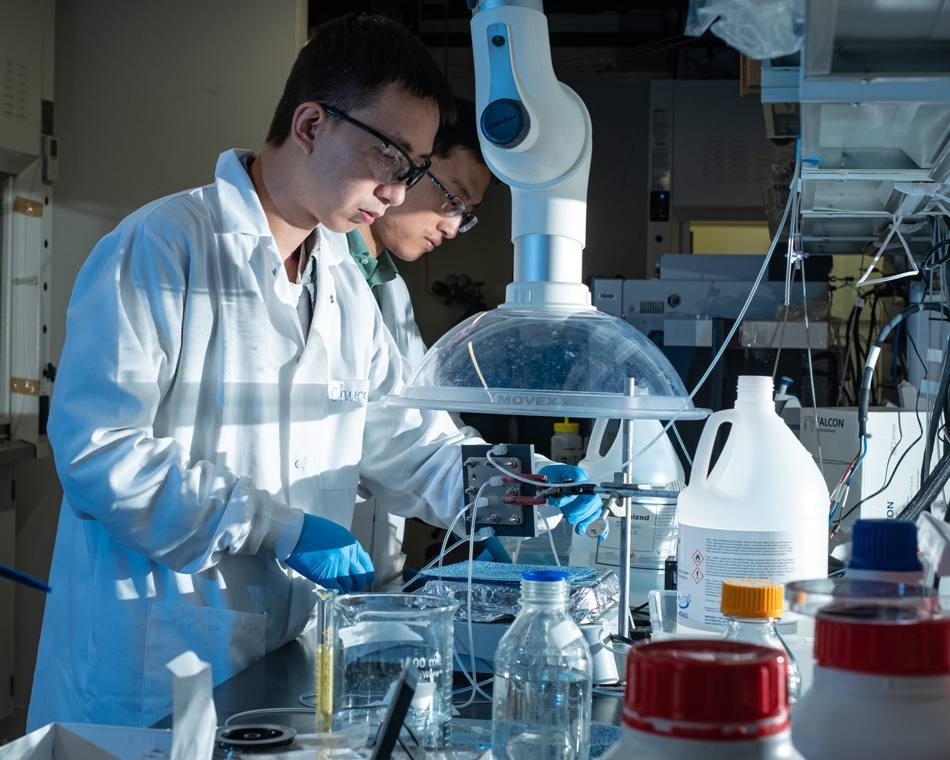Sep 4 2019
An electrolyzer, which utilizes renewable electricity to synthesize pure liquid fuels, could be used to repurpose a common greenhouse gas in an efficient and eco-friendly manner.
 Rice postdoctoral researcher Chuan Xia, left, and chemical and biomolecular engineer Haotian Wang adjust their electrocatalysis reactor to produce liquid formic acid from carbon dioxide. (Image credit: Jeff Fitlow)
Rice postdoctoral researcher Chuan Xia, left, and chemical and biomolecular engineer Haotian Wang adjust their electrocatalysis reactor to produce liquid formic acid from carbon dioxide. (Image credit: Jeff Fitlow)
Haotian Wang, a chemical and biomolecular engineer from the Rice University lab, developed the catalytic reactor that utilizes carbon dioxide gas as its feedstock. In its new prototype, the reactor generates formic acid that is highly concentrated and highly purified.
Wang informed that conventional carbon dioxide devices produce formic acid that requires energy-intensive and expensive purification steps. Pure formic acid solutions produced directly will help in promoting carbon dioxide conversion technologies available in the market. The technique has been described in Nature Energy.
Wang joined the George R. Brown School of Engineering at Rice University in January, and his team explores technologies that convert greenhouse gases into valuable products. Tests were conducted, in which the novel electrocatalyst achieved an energy conversion efficiency of around 42%. This implies that almost 50% of the electrical energy can be preserved in formic acid in the form of liquid fuel.
Formic acid is an energy carrier. It’s a fuel-cell fuel that can generate electricity and emit carbon dioxide—which you can grab and recycle again.
Haotian Wang, Engineer, Department of Chemical and Biomolecular Engineering, Rice University
“It’s also fundamental in the chemical engineering industry as a feedstock for other chemicals, and a storage material for hydrogen that can hold nearly 1,000 times the energy of the same volume of hydrogen gas, which is difficult to compress,” he added. “That’s currently a big challenge for hydrogen fuel-cell cars.”
According to Chuan Xia, study lead author and Rice postdoctoral researcher, two advances resulted in the latest device. The first advance was his development of a rugged, two-dimensional (2D) bismuth catalyst, and the second was a solid-state electrolyte that removes the requirement for salt as part of the reaction.
“Bismuth is a very heavy atom, compared to transition metals like copper, iron or cobalt,” stated Wang. “Its mobility is much lower, particularly under reaction conditions. So that stabilizes the catalyst.” He observed that the reactor is designed to prevent water from making contact with the catalyst, which also aids in preserving it.
According to Xia, the nanomaterials can be developed in bulk. “Currently, people produce catalysts on the milligram or gram scales,” he stated. “We developed a way to produce them at the kilogram scale. That will make our process easier to scale up for industry.”
Sulfonic acid ligands are used to coat the polymer-based solid electrolyte to conduct positive charge, or even amino functional groups to conduct negative ions.
Usually people reduce carbon dioxide in a traditional liquid electrolyte like salty water. You want the electricity to be conducted, but pure water electrolyte is too resistant. You need to add salts like sodium chloride or potassium bicarbonate so that ions can move freely in water.
Haotian Wang, Engineer, Department of Chemical and Biomolecular Engineering, Rice University
“But when you generate formic acid that way, it mixes with the salts,” he added. “For a majority of applications you have to remove the salts from the end product, which takes a lot of energy and cost. So we employed solid electrolytes that conduct protons and can be made of insoluble polymers or inorganic compounds, eliminating the need for salts.”
The concentration of the solution is determined by the speed at which the water flows via the product chamber. With the present setup, slow throughput creates a solution that has a weight of almost 30% formic acid, while faster flows make it possible to customize the concentration. The team expects to obtain higher concentrations from state-of-the-art reactors that bring out pure formic acid vapors by accepting gas flow.
In association with Brookhaven National Laboratory, the Rice lab was able to observe the ongoing process.
X-ray absorption spectroscopy, a powerful technique available at the Inner Shell Spectroscopy (ISS) beamline at Brookhaven Lab’s National Synchrotron Light Source II, enables us to probe the electronic structure of electrocatalysts in operando—that is, during the actual chemical process.
Eli Stavitski, Study Co-Author, Lead Beamline Scientist, National Synchrotron Light Source II, Brookhaven National Laboratory
Stavitski continued, “In this work, we followed bismuth’s oxidation states at different potentials and were able to identify the catalyst’s active state during carbon dioxide reduction.”
With its existing reactor, the Rice lab-produced formic acid continuously for a period of 100 hours without causing any major degradation to the reactor’s components such as the nanoscale catalysts.
According to Wang, the reactor can be easily retooled to create higher-value products like acetic acid, propanol, or ethanol fuels.
“The big picture is that carbon dioxide reduction is very important for its effect on global warming as well as for green chemical synthesis,” Wang stated. “If the electricity comes from renewable sources like the sun or wind, we can create a loop that turns carbon dioxide into something important without emitting more of it.”
Study co-authors are Rice graduate student Peng Zhu; graduate student Qiu Jiang and Husam Alshareef, a professor of material science and engineering, at King Abdullah University of Science and Technology, Saudi Arabia (KAUST); postdoctoral researcher Ying Pan of Harvard University; and staff scientist Wentao Liang of Northeastern University.
Xia is a J. Evans Attwell-Welch Postdoctoral Fellow at Rice University. Wang is the William Marsh Rice Trustee Assistant Professor of Chemical and Biomolecular Engineering.
The study was supported by Rice University and the U.S. Department of Energy Office of Science User Facilities.